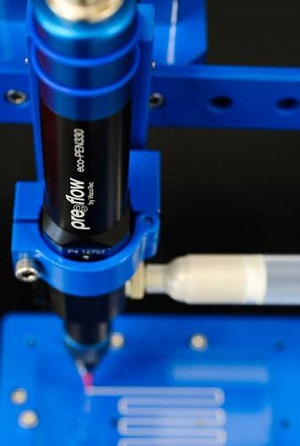Challenges in handling highly filled and abrasive materials
When it comes to electrically conductive materials, we are dealing with dispersions. They are generally referred to as electrically conductive adhesives, silicones or inks.
The materials are divided into different areas: Epoxy resins, polyurethanes, silicones and acrylates. Epoxy resins in particular stand out due to their processing and material properties. They are widely used in industry. The solids they contain correspond to the dispersion phase. They are electrically conductive. Common particle materials are silver, copper, carbon, nickel or gold.
Another conductive material is graphene, a modification of carbon with a two-dimensional structure. In addition to its high thermal and electrical conductivity, this solid is characterized by its low density and high tensile strength. At present, the first dispensing tests are being carried out to determine when the material will be available for industrial applications, but this is not yet foreseeable. According to the first results, it should be well suited for applications in the wearable and electronics industries.
Electrically conductive adhesives are used in a wide variety of industries. The automotive, aerospace and especially the electronics industries are driving the demand for electrically conductive materials. In addition to America and Europe, the Pacific-Asian region is predicted to be the core market in the future. This is related to the expected growth of the electronics industry in China and India.
Typical applications for electrically conductive adhesives
Typical applications for electrically conductive adhesives include the protection of electronic components against electrostatic discharges (ESD). But also the direct mounting of unhoused semi-conductor chips on printed circuit boards (Direct Chip Attach), where the chip is glued directly onto the substrate. These are isotropic materials that allow electricity to flow in all directions. They are also used in the assembly of surface mount devices (SMD). On the other hand, anisotropic materials are also available. They allow electricity to flow in only one direction. They are used in the manufacture of LCD connections and RFID antennas.
There is also great potential in the substitution of soldering processes for temperature-sensitive substrates. The curing temperatures of adhesives are significantly lower than those of soldering processes. They are also more flexible than solder metals and can withstand vibrations better. There are also solvent-free adhesives which are more environmentally friendly than solder metals.
Solids in electrically conductive materials
The particles in electrically conductive materials often have a diameter of 25 µm and more. As a rule, these are coarse disperse systems in which the Shore hardness of the particles exceeds D90. The solids content varies depending on the material manufacturer and application. Usually it is between 75 % and 90 %, so it can be considered as highly filled and abrasive materials.
The difference in density between the dispersion phase and the dispersion material can lead to sedimentation.
Industrial applications, however, require a homogeneous product, since a uniform solids content is required for a valid process. For this reason, suitable dispersion agents are selected that prevent or reduce sedimentation during storage and processing of the product. This results in high viscosities for electrically conductive materials. When dispensing these materials, users are faced with the challenge of dispensing abrasive material with a high degree of accuracy, independent of viscosity. This guarantees process reliability and reduces material costs.
Dispensing devices for electrically conductive materials
ViscoTec – specialized in transferring, processing and dispensing highly viscous, structure-sensitive and solids-laden liquids – offers precise dispensing solutions with its preeflow brand. Due to the properties of abrasive fillers, pump types such as peristaltic or rotary lobe pumps are only conditionally suitable for dispensing highly filled materials. preeflow microdispensers have proven themselves in this field.
As a progressive cavity pump, they are among the rotating positive displacement pumps. The stainless steel rotor moves eccentrically in an elastomer stator. The interaction of rotor and stator creates chambers. The size of the alternating opening chambers is also constant during rotation, so that there is no compression of the transferred product. Due to this dispensing geometry, a constant volume is always transferred per revolution in proportion to the angle of rotation. Independent of the viscosity of the dispensing material and with pulsation-free product flow.
preeflow microdispensing devices
The pump technology of the endless piston principle has additional advantages over other dispensing mechanisms. Filling and dispensing valves can be dispensed with in over 95 % of all applications. A retraction (reversal of the direction of rotation of the dispenser) results in a controlled thread breakage and dripping is prevented. Thread pulling gels, resins or adhesives can therefore be dispensed more precisely.preeflow guarantees a dispensing accuracy of 99 % (depending on the medium) up to a quantity of 1 µl. Thanks to the compression-less transferring, highly viscous abrasive and shear sensitive materials can also be applied.
For the exact dispensing of abrasive materials, ViscoTec has developed a new stator for the preeflow microdispenser eco-PEN330. The main change is a new stator material, which resists the high mechanical loads of highly filled materials even better. The user benefits from even greater process reliability and longer maintenance cycles.
For more information, visit www.preeflow.com









